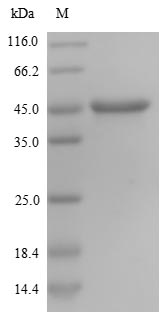The recombinant Human NES was expressed with the amino acid range of 1321-1569. The expected molecular weight for the NES protein is calculated to be 27.8 kDa. This NES protein is produced using yeast expression system. The NES gene fragment has been modified by fusing the N-terminal 6xHis tag, providing convenience in detecting and purifying the recombinant NES protein during the following stages.
The human Nestin (NES), an intermediate filament protein, is a marker for neural stem and progenitor cells. NES plays a crucial role in maintaining the structural integrity of neural cells during development and in adult tissues. NES is prominently expressed in various regions of the developing nervous system, such as the neural tube, where it contributes to the formation and maintenance of neuroepithelial cells. In adult tissues, NES expression is often associated with areas of active neurogenesis and tissue repair. Beyond its role as a structural protein, NES is considered a marker for neural stem cells and is involved in regulating cell proliferation and differentiation in response to developmental signals and injury. Research on NES spans neurodevelopment, neural stem cell biology, and its potential implications in neurodegenerative diseases and regenerative medicine.




